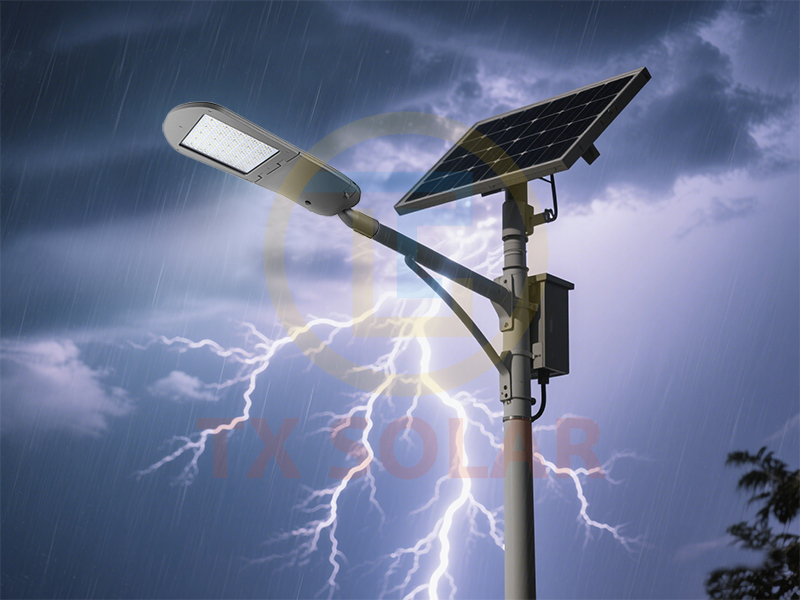During the summer when lightning is frequent, as an outdoor device, do solar street lights need to add additional lightning protection devices? Street light factory Tianxiang believes that a good grounding system for the equipment can play a certain role in lightning protection.
Lightning protection grounding methods for solar street lights
Choosing different types of grounding devices is the first step in lightning protection for solar street lights. Common grounding devices include steel bar grounding, power grid grounding, and ground grid grounding. The specific implementation steps are as follows:
1. Steel bar grounding method
Dig a 0.5m deep pit under the base of the solar street light, place a 2m long steel bar, then connect the base of the solar street light to the steel bar, and finally fill the pit.
2. Power grid grounding method
Connect the wires of the solar street light to the nearby power grid pole to connect the circuit of the solar street light to the ground grid.
3. Ground grid grounding method
Dig a 1m deep pit under the solar street light, use a ring-shaped cable to connect the solar street light through a metal stake and a steel bar grid to the underground, and then fill the pit with concrete.
Precautions for lightning protection grounding of solar street lights
1. The grounding device must have good contact with the solar street light itself.
2. Choose an appropriate grounding depth. It should not be too shallow, as it may increase the grounding resistance; it should not be too deep, as it may cause the soil to be too moist, reducing the grounding resistance and affecting the overall grounding system.
3. Regularly check the grounding lines and grounding resistance to ensure the integrity of the grounding system.
Tianxiang’s solar street lights are all equipped with grounding cages, which are made of steel bars and already play a certain role in lightning protection.
Secondly, lightning usually strikes tall buildings or metal spires, rather than randomly attacking any object. After all, physical properties limit its generation principle. Our solar panels are not sharp and are not very tall, so the probability of being struck by lightning is relatively low.
Thirdly, we can refer to authoritative lightning research materials. Here is a quote: “According to statistics, more than 4,000 people are struck by lightning worldwide each year. If the world’s population is 7 billion, the average probability of each person being struck by lightning is about one in 1.75 million. According to the Federal Emergency Management Agency of the United States, the average probability of an American being struck by lightning is one in 600,000.” The probability of one out of 1,000 sets of solar street lights being struck by lightning each year is 1,000 * 1/600,000 = 1.6‰, which means it would take 2,500 years for one set to be struck out of 1,000 sets.
There is another supplementary reason. Why do most city power supplies have lightning protection measures? It is because city power supplies are connected in parallel and series, and if one lamp is struck by lightning, it may damage dozens of nearby lamps. However, solar street lights do not need to be connected to each other and do not have series or parallel connections.
In conclusion, we believe that solar street lights do not need additional lightning protection measures. Here are some of our experiences:
1. If the height of the solar street light is low and there are taller buildings or trees nearby to attract lightning, the probability of being directly struck by lightning is relatively low.
2. Modern solar panels are not sharp conductors and often use non-metallic frames, making them less likely to attract lightning.
3. In areas with high lightning activity, a complete lightning protection system (grounding + SPD + lightning rod) must be installed.
Post time: Apr-16-2025





